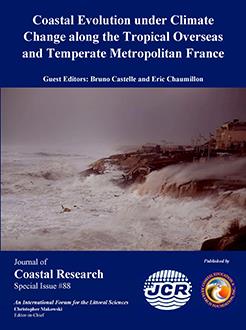Chaumillon, E.; Cange, V.; Gaudefroy, J.; Mercle, T.; Bertin, X., and Pignon, C., 2019. Controls on shoreline changes at pluri-annual to secular timescale in mixed-energy rocky and sedimentary estuarine systems. In: Castelle, B. and Chaumillon, E. (eds.), Coastal Evolution under Climate Change along the Tropical Overseas and Temperate Metropolitan France. Journal of Coastal Research, Special Issue No. 88, pp. 135-156. Coconut Creek (Florida), ISSN 0749-0208.
This article examines the morphological evolution of 27 beaches, including sandy and mixed sandy and rocky beaches, located along a 460 km-long complex shoreline, indented by four incised-valleys. The wave climate, simulated numerically from 1999 to 2017 in front of each beach, allows distinguishing between exposed and sheltered beaches. The morphological changes are quantified at two time scales: the last two centuries, from old maps and aerial photos, and the last two decades, from topographic profiles, aerial photos and satellite images. The first-order parameters explaining most of the spatial variations in the shoreline evolutions are the presence or absence of bedrock outcrops in the foreshore and/or shoreface and the presence or absence of tidal inlets close to the beach. The fastest shoreline changes are observed along exposed sandy beaches close to tidal inlets, whereas moderate to slow evolutions are mainly observed along exposed beaches with rocky foreshore and sheltered beaches. Huge shoreline changes located close to tidal inlets are related to changes in littoral drift orientation and intensity, themselves related to changes in beach orientation. Maximum erosion rates at a decadal time scale are not associated with isolated exceptional storms, but rather with clusters of storms. Beaches evolutions on this indented shoreline are controlled by geological factors (coastal orientation and the basement topography) and display complex patterns that cannot be clearly related to past changes in wave climate and sea level rise, complicating the prediction of their future evolutions.





